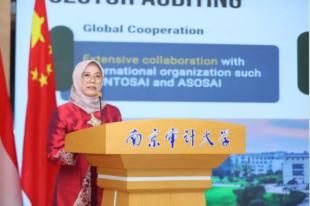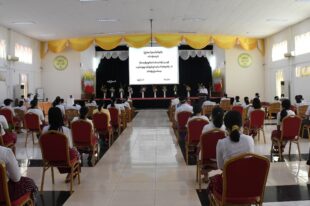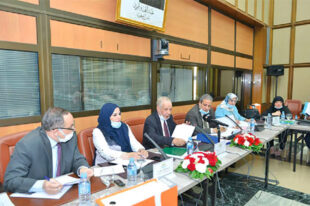Building a Sustainable Future: The National Audit Office of Tanzania Audits Infrastructure for Resilience and Innovation

Author: Mr. Charles Edward Kichere, Controller and Auditor General of the United Republic of Tanzania
1.0 Introduction
Assessing infrastructure resilience is key to mitigating risks, enhancing service delivery, and ensuring long-term value for citizens. Rigorous audits allow us to identify areas for improvement, strengthen governance, promote accountability, and optimize resource utilization. Given the pressures of urbanization, climate change, and technological progress, infrastructure planning and management must be forward-thinking, inclusive, and adaptive to evolving challenges.
The role of auditors in infrastructure projects is multi-faceted, and their responsibilities can be broken down into several key areas, including their work in financial accountability, performance assessment, transparency, risk management, and sustainability. Auditors contribute to the success of infrastructure projects, ensuring they are completed on time, within budget, and in a way that maximizes their long-term value. Independent oversight helps prevent corruption, improves governance, and ensures that infrastructure systems whether roads, energy grids, or water systems serve the public efficiently and equitably. Ultimately, the work of auditors in infrastructure is key to building a prosperous, sustainable future for nations around the world.
This article explores the role of Supreme Audit Institutions (SAIs) in auditing public infrastructure, their methodologies, and the emerging trends shaping the future of infrastructure audits through the perspective and experiences of the National Audit Office of Tanzania. Through a focus on key infrastructure sectors such as transportation, water, energy, and telecommunications, the National Audit Office of Tanzania shares a comprehensive overview of how our auditors assess projects for efficiency, innovation, and sustainability.
2.0 Initiatives Taken by NAOT to Improve the Audit of Infrastructure
Over the years, Supreme Audit Institutions (SAIs) have adjusted their auditing methodologies to keep pace with the growing complexity of infrastructure projects. SAIs, such as the National Audit Office of Tanzania (NAOT), have introduced various innovative initiatives to improve the quality and effectiveness of infrastructure audits. These efforts have significantly enhanced the transparency, accountability, and overall effectiveness of infrastructure audits. Figure 1 provides key initiatives taken by NAOT in the past five years to strengthen the audit process:

3.0 Main Focus Areas during the Audit of Infrastructure
The audit of public infrastructure projects covers several critical focus areas, which can be examined at different stages of the infrastructure development process. These audits typically focus on three main aspects:
- Infrastructure planning and implementation at the national level (nationwide infrastructure),
- Project-specific audits, and
- Areas of common problems or challenges in infrastructure development.
The main focus areas during the audit of infrastructure are presented in Figure 2.

Figure 2: Main Focus Areas During the Audit of Infrastructure
A detailed explanation of the main focus areas during the audit of infrastructure is further described below.
Infrastructure Planning and Implementation at the National Level (Nationwide Infrastructure)
This type of audit focuses on national-level infrastructure projects, particularly those that cover an entire geographical region or the whole country. These projects often require a more holistic evaluation due to their large-scale nature and cross-cutting impact. A prime example is large-scale water distribution projects, where the audit evaluates not only the effectiveness of the infrastructure but also the broader national plan that supports it. This comprehensive approach allows NAOT to provide strategic recommendations to improve overall infrastructure planning rather than focusing solely on isolated project issues that may be affected by broader national planning challenges.
Infrastructure Project-Specific Audits
Project-specific audits focus on individual infrastructure projects, examining all aspects of the project, from planning and feasibility studies to procurement, contract management, and post-completion evaluation. In these audits, NAOT assesses several critical components to ensure the success and sustainability of each infrastructure project. The NAOT incorporates environmental and sustainability considerations into infrastructure audits by assessing the long-term impact of projects on the environment and ensuring compliance with relevant environmental regulations. This process includes evaluating resource usage, waste management, and the sustainability of construction materials and practices.
Areas of Common Problems or Challenges in Infrastructure Development
In some cases, NAOT’s audits focus on specific areas of concern that affect multiple infrastructure projects. These targeted audits allow auditors to identify recurring issues across different projects. The results enable NAOT to make broad recommendations that can be implemented across all similar projects within an organization or by a specific government agency. For instance, instead of auditing quality control in a single roadwork project, NAOT might audit several road projects and identify recurring issues. Based on this analysis, NAOT would issue recommendations to the Tanzania National Roads Agency (TANROADS) to improve quality control practices across all roadwork projects they manage.
4.0 Common Findings in Infrastructure Audits
Despite improvements in auditing practices, several recurring issues continue to emerge across audits of infrastructure projects. These issues include failure to conduct detailed feasibility studies, inadequate design of project components, cost overruns, delays in project completion, lack of maintenance planning, poor quality control, and insufficient risk management.
Additionally, an analysis of common findings from audits conducted by NAOT has been carried out. Table 1 presents the findings related to Infrastructure Planning and Implementation at the National Level (Nationwide Infrastructure), while Table 2 outlines the findings from Infrastructure Project-Specific Audits.
Table 1: Common Findings from the Audits on Infrastructure Planning and Implementation at the National Level
| Aspect | Finding |
| Prioritizing National Infrastructure Investment | Inadequate identification of priorities at the national level |
| Lack of coordination between different Ministries in identifying suitable projects | |
| Insufficient criteria for the prioritization of national infrastructure | |
| Effectiveness of the prioritization process | Multiple implementations of projects that constrain funds |
| A mismatch between the prioritized infrastructure project and the allocation of funds | |
| Mobilization of resources from public and private sources | Lack of critical analysis of possible sources of funds |
| Reliance on funds from a few sources (e.g., fuel levy, railway levy, etc.) | |
| Conditions of loans for construction projects not favorable to some projects |
Table 2: Common Findings from the Infrastructure Project-Specific Audits
| Aspect of the Project Management | Finding |
| Initiation and planning | Inadequate feasibility studies of the infrastructure project |
| Inadequate planning of the construction projects | |
| Unrealistic project duration estimates with a risk of project cost escalation | |
| Inadequate preparation of plans and strategies for monitoring the construction | |
| A mismatch between feasibility study reports and the actual employer’s requirements | |
| Design of the Infrastructure | Inadequate detailed designs and specifications of the infrastructure projects |
| Inadequate preparation of bills of quantities in construction projects | |
| Non-compliance with standards, manuals, specifications, designs, and drawings | |
| Inadequate assessment of design parameters | |
| Challenges in the management of design changes and design review of the investment projects | |
| Unrealistic designs | |
| Procurement of contractors and consultants | Irregularities in the evaluation process |
| Undertaking of procurement without approving | |
| Delayed commencement of the procurement of works | |
| Weaknesses in the negotiation | |
| Unjustified Tender Board decisions | |
| Contract management | Project cost overrun |
| Key staff and equipment were not deployed at the site. | |
| Inadequate management of performance guarantee, security and bond of the contractor | |
| Materials delivered to the site and constructed items were not tested for quality. | |
| Delay in engaging supervising consultants | |
| Change in scope of work without approval. | |
| Executed works did not adequately conform to the specifications. | |
| Inadequate approval of variation orders | |
| Inadequate recovery of advance payment | |
| Abnormal increase in supervision contracts | |
| Varying minimum threshold of interim payment certificates |
5.0 Key Considerations for Effective Audit of Public Infrastructure
Effective audits of public infrastructure must take into account several crucial factors:
Expertise and technical knowledge: Due to the complex and technical nature of infrastructure projects, auditors must possess specialized knowledge in engineering, quantity surveying, architecture, contract and project management, environmental sciences, and financial management. These areas of expertise are essential for accurately evaluating the effectiveness and impact of public infrastructure projects.
Collaboration and stakeholder engagement: Effective audits require close collaboration with various stakeholders, including organizations like the Engineers Registration Board, the Architects and Quantity Surveyors Registration Board, the Public Procurement Regulatory Authority, and academic institutions. Engaging with these stakeholders ensures that auditors comprehensively understand the project and its associated complexities.
Use of Advanced Non-Destructive Testing Tools for Assessing Quality and Scope: Using high-tech testing equipment and software, like concrete test hammers, concrete thickness gauges, reinforced concrete rebar detectors, and Geographic Information Systems (GIS) during the auditing process, makes them more useful. These tools help auditors monitor project performance, identify potential issues early, improve transparency, and ensure infrastructure projects progress as planned.
Long-Term Impact Assessment: Auditors should also focus on assessing the long-term sustainability and resilience of infrastructure projects. This process involves evaluating how well the infrastructure will perform over time, considering potential future challenges such as climate change, population growth, and evolving societal needs.
6.0 Emerging Trends and Future Directions in the Audit of Infrastructure
Several emerging trends are reshaping the landscape of public infrastructure audits and are expected to significantly influence the direction of future audits. These trends reflect the evolving challenges and opportunities in infrastructure development, driven by technological advancements, global environmental changes, and an increasing focus on sustainability. Auditors are now placing greater emphasis on assessing the resilience of infrastructure projects. As infrastructure projects increasingly incorporate innovative technologies, auditors will play a crucial role in assessing how well these technologies are integrated into the projects. Auditors will have to look at the ability of these technologies to be scaled up, their cost-effectiveness, and their effect on the environment to ensure they meet the needs of stakeholders and contribute to long-term sustainability goals.
These emerging trends reflect a broader shift in the way infrastructure is being developed and managed. As sustainability, technology, and global collaboration become more central to infrastructure projects, auditors will need to adopt new methodologies, tools, and expertise to address the challenges and opportunities of the future. Auditors can ensure that infrastructure projects are effective, efficient, resilient, sustainable, and aligned with the needs of future generations by embracing these trends.
7.0 Conclusion and Way Forward
Auditing public infrastructure is crucial for ensuring the effective and responsible use of public funds. As infrastructure projects become more complex and interconnected, the role of auditors is expanding beyond traditional financial oversight. Today, auditors are tasked with performance evaluations, sustainability assessments, and resilience considerations. SAIs can help governments reach their infrastructure goals efficiently, fairly, and sustainably by using cutting-edge technology, working with stakeholders, and focusing on long-term effects.
Furthermore, INTOSAI P-12 (The Value and Benefits of SAIs) has been realized while auditing infrastructure by ensuring that public investments are directed towards sustainable and resilient infrastructure, ultimately benefiting the country’s economy and society. Through these infrastructure audits, NAOT has provided valuable insights that enhance transparency, accountability, and long-term value in infrastructure development.
Looking ahead, the future of infrastructure auditing will increasingly focus on ensuring that projects are resilient to emerging challenges. Auditors will play a key role in assessing the capacity of infrastructure to adapt to issues like climate change, population growth, and technological advancements. Once adequately implemented, it will help build more sustainable, innovative, and inclusive societies.





